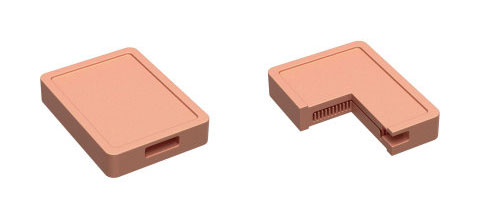Desktop Metal Qualifies Commercially Pure Copper for Additive Manufacturing
Production System binder jetting technology enables the mass production of high-performance copper parts for automotive, aerospace and electronics.

Binder jetting on the Production System can produce the part as a single component, reducing manufacturing and operational complexity, part cost, and lead time. Image courtesy of Business Wire.
Latest News
December 27, 2021
Desktop Metal has qualified commercially pure copper (>99.95% purity) for additive manufacturing on the Production System platform, which leverages Single Pass Jetting (SPJ) technology designed to achieve the fastest build speeds in the metal additive manufacturing industry.
Customers can now leverage SPJ technology for the production of high-performance copper parts at scale across various industries, including automotive, aerospace and electronics.
With its thermal and electrical conductivity, commercially pure copper is an ideal material for applications requiring heat or electricity transfer, such as cold plates, pucks and manifolds, heat sinks, heat exchangers, and bus bars used in power-intensive electrical applications, the company reports. It is reportedly the third-most-consumed industrial metal in the world.
“Copper has been a highly requested material from many of our customers and prospects, and has applications spanning a broad variety of industries, from thermal hardware found in air and liquid cooling systems to conformally cooled coils for transmission of high frequency currents,” says Jonah Myerberg, co-founder and CTO of Desktop Metal.
Desktop Metal’s materials science team has qualified and fully characterized commercially pure copper (C10300) printed on Production System technology with greater than 99.95% purity, enabling thermal and electrical conductivity. Manufacturers can now print copper parts on the Production System with geometric complexity in a single step instead of brazing multiple conventionally produced copper components together.
With the geometric freedom enabled by binder jetting, engineers can also explore new, high-performance designs, such as the lattice structures and conformal cooling channels to improve heat transfer.
An example of a key application includes:
Liquid Cooling Plate
Liquid cooling plates are used to regulate temperature on high-performance microprocessors. Coolant flows through the fins, which provide a large surface area to transfer heat from the passing fluid to the heat sink to cool the chip that is attached to the outer body.
These cooling geometries typically require long lead time and skilled labor-intensive production processes, such as skiving and machining. In addition these commonly used conventional manufacturing processes are subtractive and produce excess scrap material, increasing part costs.
In contrast to conventional production methods for this liquid cooling plate, binder jetting on the Production System can produce the part as a single component, reducing manufacturing and operational complexity, part cost and lead time, the company reports. The Production System enables capacity to print hundreds of cooling plates per day.
Desktop Metal says copper is the ideal material for heat exchangers due to its conductivity, maximizing heat dissipation from the electronic chip to the cooling fluid.
The Production System
Created by the inventors of binder jetting and single-pass inkjet technology, the Production System is an industrial manufacturing platform powered by Desktop Metal’s SPJ technology. It is designed to production quantities of up to millions of parts per year at costs competitive with conventional mass production techniques, the company reports.
The Production System platform consists of two printer models: the P-1, a solution for process development and serial production applications, and the P-50, a large form factor mass production solution for end-use parts. The Production System combines Desktop Metal engineered binders with an open material platform, allowing customers to produce high-performance parts using the same low-cost metal powders used in the Metal Injection Molding (MIM) industry.
An inert processing environment enables compatibility with various materials, including high-performance alloys and even reactive metals, such as aluminum and titanium.
In addition to copper, the materials library for the Production System platform has expanded to include D2 tool steel, 420 stainless steel, nickel alloy IN625, 4140 low-alloy steel, 316L stainless steel, and 17-4PH stainless steel, each of which have been qualified by Desktop Metal. The platform also supports several customer-qualified materials, including silver and gold, and Desktop Metal plans to add additional metals to its portfolio, including tool steels, stainless steels and superalloys.
To learn more about copper and the Production System materials portfolio, click here.
Sources: Press materials received from the company and additional information gleaned from the company’s website.
Subscribe to our FREE magazine, FREE email newsletters or both!
Latest News
About the Author
DE’s editors contribute news and new product announcements to Digital Engineering.
Press releases may be sent to them via DE-Editors@digitaleng.news.






